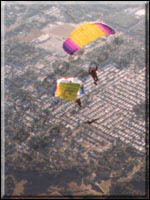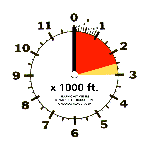An incident recently accrued to prompt me to talk about photographing wraps.

Generally when organizing photographers I ask ahead of
time who wants to chase them. For the most part the dive is over. Some
times in the aftermath of a wrap the formation can continue to build. So
in that case it is a good idea to decide ahead of time who will remain
and who will chase the wrap.
There are several things to think about when considering if you should cover these spectacles.
Quick Facts:
Chasing a wrap will put you or some times the other canopy workers at greater risk.
You never want to find yourself in the path of these wirly twirlies!
A wrap with a partially flying parachute can 180 degree in a heart beat.
Never film on the same level or below a wrap with a partially flying canopy.
Your CReW group should be informed as to your intentions.
Chasing a wrap will put you or some times the other canopy workers at greater risk: We have seen instances where sometimes camera men have become participants and not just observers. Camera men have a responsibility to remain safe observers. The camera man should never be a consideration for your team mates involved in a wrap. You must always be the last thing on their minds. This means knowing where to safely fly.
You never want to find yourself in the path of these wirly twirlies!: Beneath a formation is a place I call the wrap corridor. This is a area where there is a great potential for wraps to fall from the formation. Great caution should be used in flying in this area. This space is approximately 30 to 45 degree below and behind a building formation. This is a heads up, eyes always open place to fly.
A wrap with a partially flying parachute can turn 180 in a heart beat: Chasing an ensuing wrap will require some discipline in maintaining a safe distance. Wraps can take unpredictable and often uncontrollable headings. The pilot will not want to make any avoidance maneuvers for you. Often if one canopy is left flying the pilot will have hundreds of pounds hanging from some part of his body. He may be struggling just to maintain a heading. If he is forced to make a turn he could lose control and add G-forces to the suspended weight. This will not only endanger the individuals in the wrap but may make you a part of it.
Wrap fixation will block out all other visual perception. (Tunnel Vision) More than one canopy chasing a wrap can result in collisions or close calls and the chase should be abandoned: It has been observed time and time again that individuals filming or observing a wrap seldom take notice of one another until its to late. You adrenaline will be peaking. Your attention and focus will exclude all else. If you're alone you may be all right. Chances are you will not. Be aware, it's the canopy you don't see that will get you. Remain alert, if you do see someone else, do the prudent thing, abandon your pursuit.
Never film on the same level as a wrap with partially flying canopies. Never film on the same glide slope behind partially flying canopies: I have noted that most wraps contain canopies that are still flying. As I mentioned earlier they can turn on a dime. The table can turn from observer to participant in a heart beat. It is for this reason that they should be given a wide berth. Remain higher than the wrap. Stay out of its glide slope. If you find yourself there remain off center, gear will eject on that plane. Remain alert for heading changes.
If you decide to chase a wrap, your chances of landing back at the airport will decrease the lower you chase it. Out of courtesy you will be expected to help in the retrieval of lost gear. (Free bags & Cutaway Mains): Canopy Relative Work very often takes place many miles from the Drop Zone. The heading of the formation coupled with its 1000 ft per minute decent rate will put you back on the airport provided the dive proceeds as planned. Wraps add a unpredictable element to making it back. Your accuracy skills need to be current. You may be landing in a congested residential area with power lines, or on some fire road in the middle of the woods. In either case be comfortable with your ability to find a safe landing area. Look for smoke or other wind indicator to set up a safe landing.
Getting out of a wooded area can take awhile. Look for a route out long before landing. Once below the tree tops it may be difficult to find a quick route out.
If you're landing with or near gear look for references to guide you there. If the gear is inaccessible make note of its location. A stack of rocks or a stick indicating its direction will help when this location is revisited. One important note, never endanger your self for the gear. If it is obvious the gear will land in an area that is difficult to land in don't chase it. Pick a safe landing area.
Your CReW group should be informed as to your intentions. Address everyone at the dirt dive. Inform everyone of the proper protocol, encourage the spectators to keep a respectable distance. Make everyone on that load aware that a camera will be in close pursuit. It will be the well meaning individual that will want to help save the gear that will wrap you. He will be as visually fixated on the action as you are. If more than one photographer is on the load elect only one to film the wraps. Even in the case of multiple wraps. Often these wraps will be in close proximity. Make sure you camera partner is well informed in the protocol necessary to following a wrap.
Quick rules for the photographer: Never film from on level or below a wrap. Never approach a partially flying wrap from head on. Avoid following in the glide path of a flying wrap. Always remain a little to the side of center. Try to estimate the path where cutaway gear may eject. Spinning wraps should be approached with wide orbits, cutaway gear will exit up and out. Keep clear of this area. Pick a safe landing area.
![]()
